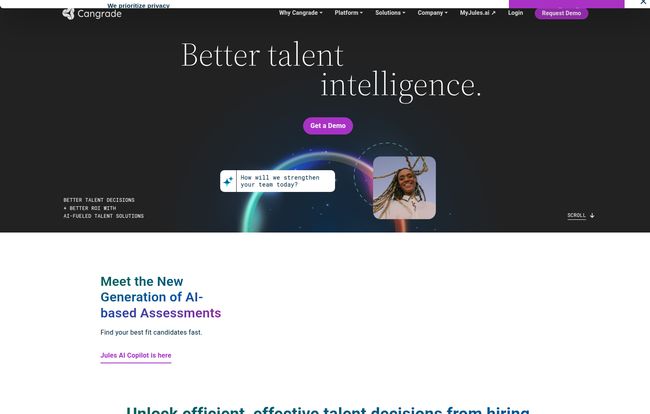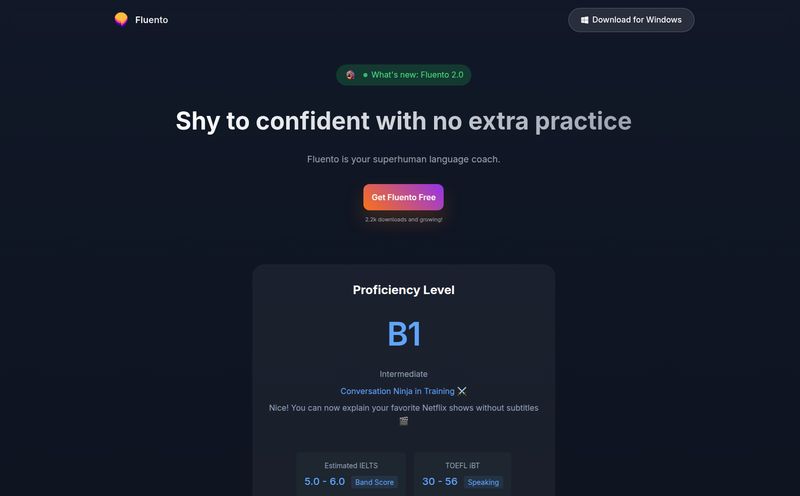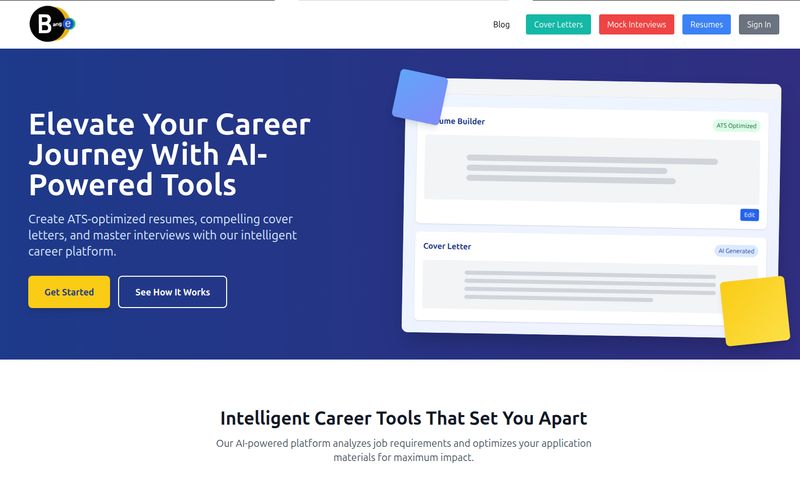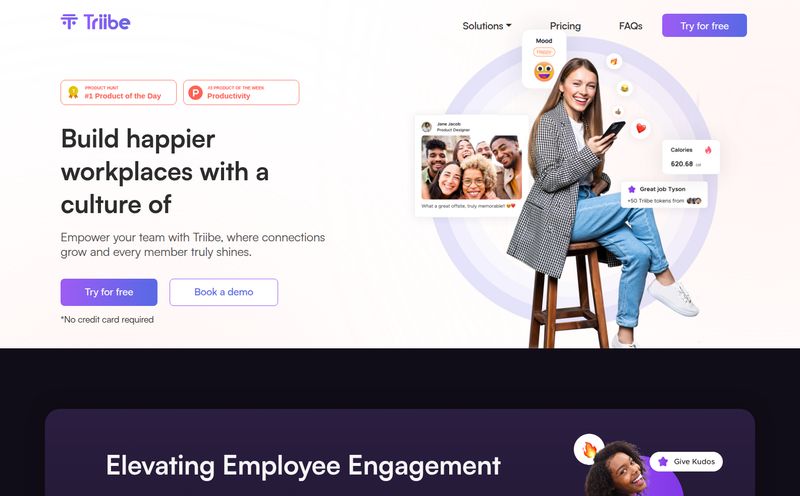We’ve all been in those hiring meetings. The ones fueled by lukewarm coffee and a stack of resumes that all start to look the same after the fifth one. You’re trying to balance what the paper says with that ever-elusive “gut feeling.” Sometimes you strike gold. Other times… well, you end up with a great person in the wrong role, and you're back at the drawing board six months later.
For years, hiring has been this weird mix of art and science, often leaning way too heavily on the art. But the landscape is shifting. The buzzword floating around is “talent intelligence,” and it’s not just another piece of corporate jargon. It’s about replacing that gut feeling with actual, predictive data. And that’s where platforms like Cangrade come storming in, promising to be the co-pilot your HR team has been dreaming of. But does it actually deliver? I've seen a lot of tech promise to revolutionize things, so my curiosity was definitely piqued.
What Exactly is Cangrade? More Than Just Another HR Tool
First off, let’s clear up what Cangrade isn’t. It’s not just an Applicant Tracking System (ATS) or a simple job board. Think of it less like a filing cabinet for resumes and more like a full-blown analytics department for your entire talent strategy. It's a platform designed to give you deep insights across the entire employee lifecycle, from the first application to their potential for internal promotion years down the line.
It’s the difference between a baseball scout watching a player and saying “He’s got a good swing” and a data analyst breaking down bat speed, launch angle, and performance against left-handed pitchers. One is an observation; the other is actionable intelligence. Cangrade aims to be the latter for your people operations. It covers both Talent Acquisition (getting the right people in the door) and Talent Management (keeping them happy and helping them grow). That comprehensive approach is what caught my eye initially.
The “Cangrade Difference”: Digging into the Core Features
Okay, so what’s actually under the hood? Cangrade is built on a suite of tools that work together. It's not just one magic bullet, but a whole arsenal.
Revamping Your Talent Acquisition Funnel
This is where most of us feel the immediate pain. Cangrade tackles the top of the funnel with some pretty smart tools. Their Pre-Hire and Skills Assessments go way beyond a simple personality quiz. They're designed to predict job success, and Cangrade boldly claims this can lead to finding 10x more qualified candidates. That’s a massive claim, but if you're sifting through hundreds of applicants, a tool that surfaces the top 10% with data to back it up is a game-changer.
Then you have Structured Interview Guides and Video Interviews. This is all about standardization. It ensures every candidate gets a fair shake and that interviewers are asking questions that actually predict performance, not just ones they thought of in the car on the way to work. It helps remove the “I hired them because we both like the same football team” bias. Which, we all know happens.
Beyond the Hire: Talent Management and Retention
This is where I think things get really interesting. Hiring is expensive, but losing a great employee is even more costly. Cangrade has tools specifically for this. Their Retention Forecast is a wild concept—it uses data to predict which employees might be a flight risk. Imagine being able to proactively address an issue before your star performer even starts polishing their LinkedIn profile. That’s powerful stuff.
They also feature an Internal Talent Marketplace. This is huge for internal mobility. Instead of losing talented people who feel stuck, you can create a clear path for them to find new opportunities within your own company. It’s about building careers, not just filling jobs. And of course, there are modules for Employee Onboarding and Workforce Development to make sure you're nurturing the talent you worked so hard to find.
Let's Talk About the AI: Meet Jules, Your HR Copilot
You can’t talk about Cangrade without talking about the AI. They’ve even given it a name: Jules. In an era where every other software is slapping an “AI-powered” sticker on its box, Cangrade seems to be building its entire philosophy around it. Jules is the brain that powers the predictive analytics, the candidate matching, and the retention forecasts.
But here's the most important part: their focus on Ethical AI. The fear with AI in hiring is that it will just learn and amplify existing human biases. Cangrade directly confronts this, claiming an 81% reduction in bias. They do this by focusing on data points that are proven to correlate with job success, not demographics or pedigree. It’s a move from pattern-matching resumes to predicting potential. It’s a subtle but profound shift in thinking.

Visit Cangrade
Some people will argue that taking the human element out of hiring is a bad thing. In my experience, it’s not about removing humans; it’s about freeing them up to do what they do best. Let the AI sift teh data and identify the top candidates. Let your recruiters spend their time conducting meaningful, in-depth conversations with a highly qualified, diverse pool of applicants. The AI isn't the hiring manager; it's the world's best assistant.
The Good, The Bad, and The Realistic: A Candid Look at Cangrade
No tool is perfect. As an SEO and traffic guy, I'm a professional skeptic. So let's break it down without the marketing gloss.
The Big Wins
The promise of measurable ROI is huge. HR has traditionally been seen as a cost center, but with stats like a 27% higher success ratio for new hires, Cangrade gives HR leaders the data they need to prove their strategic value. The focus on candidate experience is another major plus. Their site boasts a 98% candidate satisfaction rate. Even if someone doesn't get the job, leaving them with a positive, fair impression of your company is fantastic for your employer brand.
And from a technical standpoint, the fact that it’s built to integrate easily with your existing HR tech stack is a massive relief. Nobody wants another disconnected data silo. That shows a real understanding of the modern enterprise environment.
Potential Hurdles
Let's be real, a platform this comprehensive is going to have a learning curve. You're not just buying a tool; you're adopting a new way of thinking about talent. It will require buy-in and training. The other concern, the one about reducing human interaction, is valid but maybe misplaced. It changes the nature of the interaction, hopefully for the better.
And then there's the cost. Cangrade doesn’t list their pricing publicly, which is typical for enterprise-level SaaS. This usually means it's a 'request a demo' situation with pricing tailored to your company's size and needs. It's safe to assume this isn't a tool for a five-person startup. It's an investment for companies that are serious about optimizing their talent strategy at scale.
So, Who is Cangrade Really For?
After digging in, a clear picture of the ideal Cangrade customer emerges. It's for the mid-to-large-sized organization that is feeling the acute pain of talent acquisition and retention. It’s for the company that is serious about its Diversity, Equity, and Inclusion (DE&I) goals and wants a tool to help them make hiring more equitable. Most of all, it’s for the forward-thinking HR leader who wants to stop guessing and start making strategic, data-backed decisions that impact the bottom line.
If you're a Head of People who wants to walk into a board meeting and talk about predictive retention models instead of just cost-per-hire, this is a platform you should probably be looking at.
In the end, the world of work is becoming more data-driven every day. Marketing has had its analytics platforms for years, as have sales and finance. Talent intelligence platforms like Cangrade are finally bringing that same level of analytical rigor to HR. It’s not about creating an army of robot recruiters; it's about giving your human recruiters a super-suit. And in today’s competitive talent market, who wouldn't want that advantage?
Frequently Asked Questions about Cangrade
- Is Cangrade an Applicant Tracking System (ATS)?
- Not exactly. While it has features that overlap, Cangrade is a talent intelligence platform that integrates with your ATS. It provides the predictive analytics and assessment layer on top of the administrative functions of an ATS.
- How does Cangrade ensure its AI is unbiased?
- According to their site, their AI is built and validated by I/O psychologists to focus only on job-relevant data points. It's designed to ignore demographic information and other potential sources of bias, focusing instead on skills, abilities, and traits that predict success in a specific role, which they claim reduces bias by up to 81%.
- What kind of companies use Cangrade?
- While they don't list specific clients prominently on the homepage, the platform is best suited for medium to large enterprises that handle a significant volume of hiring and are focused on strategic initiatives like employee retention and DE&I.
- How much does Cangrade cost?
- Cangrade does not publish its pricing online. This typically means they operate on a custom-quoted, enterprise SaaS model. You'll need to contact their sales team for a demo and a price based on your company's size and needs.
- Can Cangrade really predict if an employee will quit?
- Yes, that's the goal of their Retention Forecast feature. It analyzes various data points to identify employees who may be at risk of leaving, allowing managers to intervene proactively. It's a predictive tool, not a crystal ball, but it aims to provide a powerful leading indicator.



